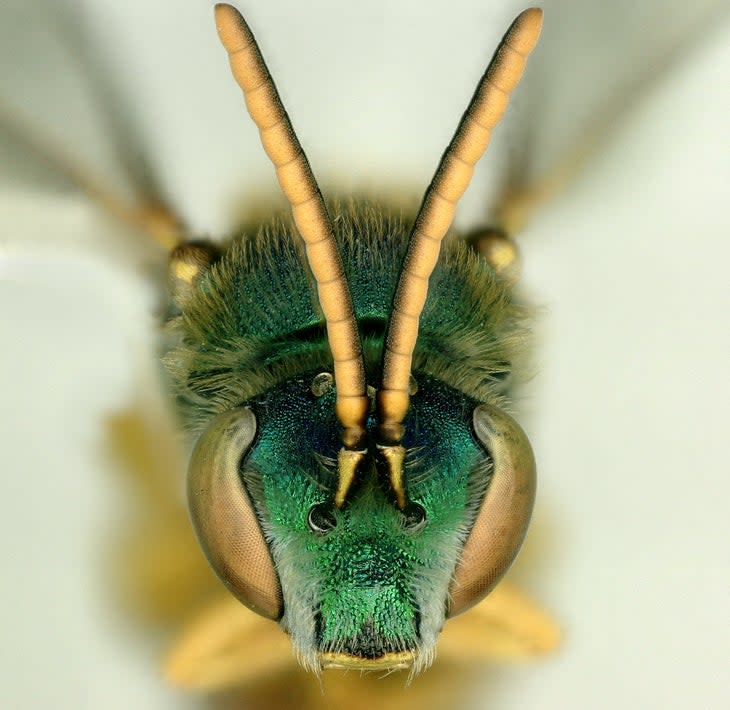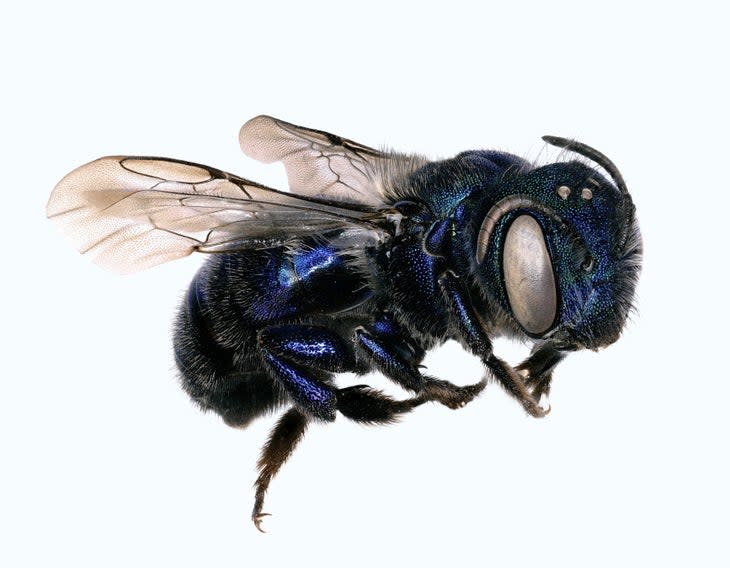Native Bee Species Still Need Saving
This article originally appeared on Vegetarian Times
In the pollinator meadow at the Natural History Museum of Los Angeles, the bee hotels are bustling with activity. Armed with massive pincers, leafcutter bees from the family Megachilidae dart in and out of the neat rows of tubes drilled into the tall wooden structures, which they have lined with snippets of plant matter and separated into tiny compartments for their larvae to live in.
Leafcutters are just one of the numerous native bee species attracted to this little slice of pollinator heaven, which features a colorful patchwork of plants from the local ecosystem. Look closely at a nearby cluster of bright yellow bush sunflowers, and you might spot long-horned bees capturing pollen on their fuzzy, pant-like legs. Later in the year, tiny Perdita bees -- aka "fairy bees" -- can be seen buzzing around the yarrow.
You'll find plenty of non-native honeybees in the mix too. Originally imported from Europe in the 17th century, honeybees are shipped across the nation annually to help fertilize agricultural crops, and escapees have established colonies around the country, making them a ubiquitous sight across the US. With their recognizable hives and penchant for collecting pollen from almost any type of flowering plant, they are probably the insect most Americans imagine when they hear the word "bee." But Brian Brown, head of the museum's entomology department, wishes they wouldn't take up all the attention -- especially when it comes to conversations about conservation.
"There’s a lot of confusion about what honeybees are and are not doing for conservation," says Brown. "If we’re doing things to raise honeybees, that’s not necessarily a conservation activity. They are super generalist foragers who will go to almost any kind of flower."
Instead, Brown says, he and some of the museum's other researchers prefer to "concentrate on the native bees," which often have highly specialized relationships with their native ecosystems. There are estimated to be about 4,000 of these native bee species in the United States, ranging from the massive, jet-black carpenter bee to the tiny, two millimeter Perdita minima, which is small enough to fit on the carpenter bee's antenna. Many don't look like the traditional black-and-yellow striped honeybee, and the large majority don't live in hives, preferring to burrow underground or nest in holes (like the leafcutters).
And because these insects aren't used for commercial agricultural purposes, they often get overlooked in conversations about "saving the bees" -- an issue that could have catastrophic impacts for habitat biodiversity.
"[Bees] that live in very specific habitats might have a very intimate relationship with one specific plant," says Lisa Gonzalez, the museum's Program Manager of Invertebrates. "Those are the ones that are going to be more vulnerable to population decline. Because if that one plant or that specific habitat is threatened, then you’re not going to have that bee anymore."
In the early 2000s, concerns about colony collapse disorder -- which occurs when most of the worker bees in a honeybee hive die suddenly -- dominated headlines in the U.S. Articles featured distraught beekeepers worried about the subsequent collapse of the commercial beekeeping industry, and politicians stressed the importance of protecting honeybees so that agricultural production wouldn't suffer.
The fervor around the fate of honeybees also inspired many Americans to become amateur beekeepers, setting up colonies at home to do their part to preserve these critical pollinators.
"We all have friends who, at the start of what then was called colony collapse disorder, started keeping bees in their backyard," says Lori Ann Burd, Environmental Health Director for the Center for Biological Diversity. "But keeping honeybees to 'save the bees' is like keeping chickens to save native birds -- it just doesn’t line up at all."
Today, colony collapse order has become a rarity but a complex range of stressors -- including climate change, disease, pesticides, and habitat loss -- continue to impact both honeybees and, perhaps to a greater degree, native bees, which don't have the luxury of being nursed back to health by beekeepers once the agricultural season ends.
Many of these stressors are in fact worsened by the same agricultural system honeybees are used to maintain. Factory farms, which often rely on monocultures of crops that take up large swaths of land, eliminate essentially all habitat diversity, and the transport of honeybees around the country allows diseases to spread more quickly in both industrial hives and native bee populations. Many farms also rely heavily on the use of insecticides both before crops are planted and when they are on the ground. These can be particularly harmful to ground-nesting bees, which dig burrows under the soil to lay their eggs.
"The hyper efficiency of these systems leaves very little room for anything else to grow, and no room for things like ground nesting," says Burd. "And the vast majority of native bees are ground nesting."
Maggie Sahanahan, a researcher at the University of Minnesota Bee Lab, recently published a paper urging researchers and agricultural specialists to confront the role of the agricultural system in honeybee health head on. Sahanahan says that the impacts of the agricultural industry are likely even more harmful to native bees, but fewer people are paying attention.
"Agricultural systems designed in an industrial manner really exclude native pollinators in a big way and make it difficult for them to survive," says Shannahan. "We see the way this plays out for honeybees, because we’re managing them constantly and impacts on honeybee health are really easily visible. I think they’re also visible in native bees if you’re looking, but there’s so much more attention on honeybee health."
All of this isn't to say that native bees aren't also a critical part of our food systems. In many cases, they are actually far more effective pollinators than honeybees, acting as the primary pollinator or significantly supplementing the work of honeybees in almost all crops.
"Although honeybees are really important for certain crops, native bees are a huge source of pollination for many, many other crops. Really tasty, nutritious plants, like nuts, fruits, and vegetables," says Scott Black, Executive Director of the Xerces Society for Invertebrate Conservation. "If you’re thinking of a plant-based diet, you really can thank a pollinator, and in a lot of cases, a native bee."
The Xerces Society and other organizations are helping to develop more regenerative agricultural models that incorporate plant cover and diversity into the landscape by putting hedgerows of pollinator-friendly plants between crops. They are also pushing to reduce the use and impacts of pesticides that are harmful to pollinators.
"We need to change our habits around pesticide use, especially insecticide use," says Black. "On farms, we can do that by becoming organic. Or, since that can be hard to do with certain crops, using what’s called Integrated Pest Management, which is our way to really minimize the use of pesticides and protect vital habitat areas adjacent to these crops."
Cutting down on meat production can also help with the pesticide problem, says Burd. A recent collaborative report between the Center for Biological Diversity and World Animal Protection found that about a third of agricultural lands in the U.S. are dedicated solely to growing corn and soy for feeding animals, driving 235 million pounds of herbicide and insecticide use per year.
"Not eating meat is actually a really important way that you can help bees, because eating lower on the food chain reduces the amount of land required to grow your food," says Burd.
In the meantime, scientists and bee advocates are encouraging individuals who might have otherwise participated in the backyard beekeeping movement to focus on making their homes more native bee-friendly instead. While the traditional lawn doesn't offer much for local ecosystems, adding just a few native plants to your yard can make it a haven for pollinators in an urbanized landscape. The Xerces Society has even created some handy native plant guides to help gardeners get started.
"Urban areas surprisingly have become important refuges for native diversity," says Burd. "Because they’re urban, they’re not ideal, but they’re not completely poisoned."
Even just letting your yard get a little "messy" by letting plants grow free and providing ground cover for ground-nesting pollinators can go a long way for native bees that need a safe haven. The #nowmowmay movement, which encourages people to refrain from mowing their yards for a month each year, has inspired many to share stories of how their outdoor spaces spring to life in the absence of lawncare. And many others have started embracing non-traditional, pollinator-friendly yards year round.
Brown, of L.A.'s Natural History Museum, says that while his yard filled with mulch, wood chips, and native bushes looks a little different from others on his block, his neighbors have learned to love it -- and of course, so have the bees.
"When we first put it in, we had a few people come by and say, 'oh, that looks awful,'" says Brown. "But this year, I’ve had three people come up to me and say your yard is so beautiful. I think maybe perceptions are changing a little bit -- it doesn’t have to be messy, and it can be accessible for wildlife."
RELATED: Consider the Anchovy: On the Fantasies and Lies of Tinned Fish
Get more of what you love from VT. Follow us on Instagram, Facebook, and Twitter, and sign up for our email newsletters.
For exclusive access to all of our fitness, gear, adventure, and travel stories, plus discounts on trips, events, and gear, sign up for Outside+ today.



